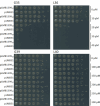A microaerobically induced small heat shock protein contributes to Rhizobium leguminosarum/ Pisum sativum symbiosis and interacts with a wide range of bacteroid proteins
- PMID: 39714151
- PMCID: PMC11784457
- DOI: 10.1128/aem.01385-24
A microaerobically induced small heat shock protein contributes to Rhizobium leguminosarum/ Pisum sativum symbiosis and interacts with a wide range of bacteroid proteins
Abstract
During the establishment of the symbiosis with legume plants, rhizobia are exposed to hostile physical and chemical microenvironments to which adaptations are required. Stress response proteins including small heat shock proteins (sHSPs) were previously shown to be differentially regulated in bacteroids induced by Rhizobium leguminosarum bv. viciae UPM791 in different hosts. In this work, we undertook a functional analysis of the host-dependent sHSP RLV_1399. A rlv_1399-deleted mutant strain was impaired in the symbiotic performance with peas but not with lentil plants. Expression of rlv_1399 gene was induced under microaerobic conditions in a FnrN-dependent manner consistent with the presence of an anaerobox in its regulatory region. Overexpression of this sHSP improves the viability of bacterial cultures following exposure to hydrogen peroxide and to cationic nodule-specific cysteine-rich (NCR) antimicrobial peptides. Co-purification experiments have identified proteins related to nitrogenase synthesis, stress response, carbon and nitrogen metabolism, and to other relevant cellular functions as potential substrates for RLV_1399 in pea bacteroids. These results, along with the presence of unusually high number of copies of shsp genes in rhizobial genomes, indicate that sHSPs might play a relevant role in the adaptation of the bacteria against stress conditions inside their host.IMPORTANCEThe identification and analysis of the mechanisms involved in host-dependent bacterial stress response is important to develop optimal Rhizobium/legume combinations to maximize nitrogen fixation for inoculant development and might have also applications to extend nitrogen fixation to other crops. The data presented in this work indicate that sHSP RLV_1399 is part of the bacterial stress response to face specific stress conditions offered by each legume host. The identification of a wide diversity of sHSP potential targets reveals the potential of this protein to protect essential bacteroid functions. The finding that nitrogenase is the most abundant RLV_1399 substrate suggests that this protein is required to obtain an optimal nitrogen-fixing symbiosis.
Keywords: NCR; Rhizobium; nitrogen fixation; oxidative stress; sHSP.
Conflict of interest statement
The authors declare no conflict of interest.
Figures







Similar articles
-
Proteome Analysis Reveals a Significant Host-Specific Response in Rhizobium leguminosarum bv. viciae Endosymbiotic Cells.Mol Cell Proteomics. 2021;20:100009. doi: 10.1074/mcp.RA120.002276. Epub 2020 Dec 6. Mol Cell Proteomics. 2021. PMID: 33214187 Free PMC article.
-
Two zinc ABC transporters contribute to Rhizobium leguminosarum symbiosis with Pisum sativum and Lens culinaris.Front Plant Sci. 2025 Jun 9;16:1598744. doi: 10.3389/fpls.2025.1598744. eCollection 2025. Front Plant Sci. 2025. PMID: 40551761 Free PMC article.
-
The hypBFCDE operon from Rhizobium leguminosarum biovar viciae is expressed from an Fnr-type promoter that escapes mutagenesis of the fnrN gene.J Bacteriol. 1995 Oct;177(19):5661-9. doi: 10.1128/jb.177.19.5661-5669.1995. J Bacteriol. 1995. PMID: 7559356 Free PMC article.
-
[Oxidation processes at initial stages of interaction of root nodule bacteria (Rhizobium leguminosarum) and pea (Pisum sativum L.): a review].Prikl Biokhim Mikrobiol. 2007 Sep-Oct;43(5):576-82. Prikl Biokhim Mikrobiol. 2007. PMID: 18038678 Review. Russian.
-
Essential roles of nodule cysteine-rich peptides in maintaining the viability of terminally differentiated bacteroids in legume-rhizobia symbiosis.J Integr Plant Biol. 2025 Apr;67(4):1077-1085. doi: 10.1111/jipb.13891. Epub 2025 Mar 19. J Integr Plant Biol. 2025. PMID: 40105505 Review.
References
-
- Zamorano-Sánchez D, Girard L. 2015. FNR-like proteins in rhizobia: past and future, p 155–166. In Brujin FJ (ed), Biological nitrogen fixation. John Wiley and Sons, United kingdom.
MeSH terms
Substances
Grants and funding
LinkOut - more resources
Full Text Sources

